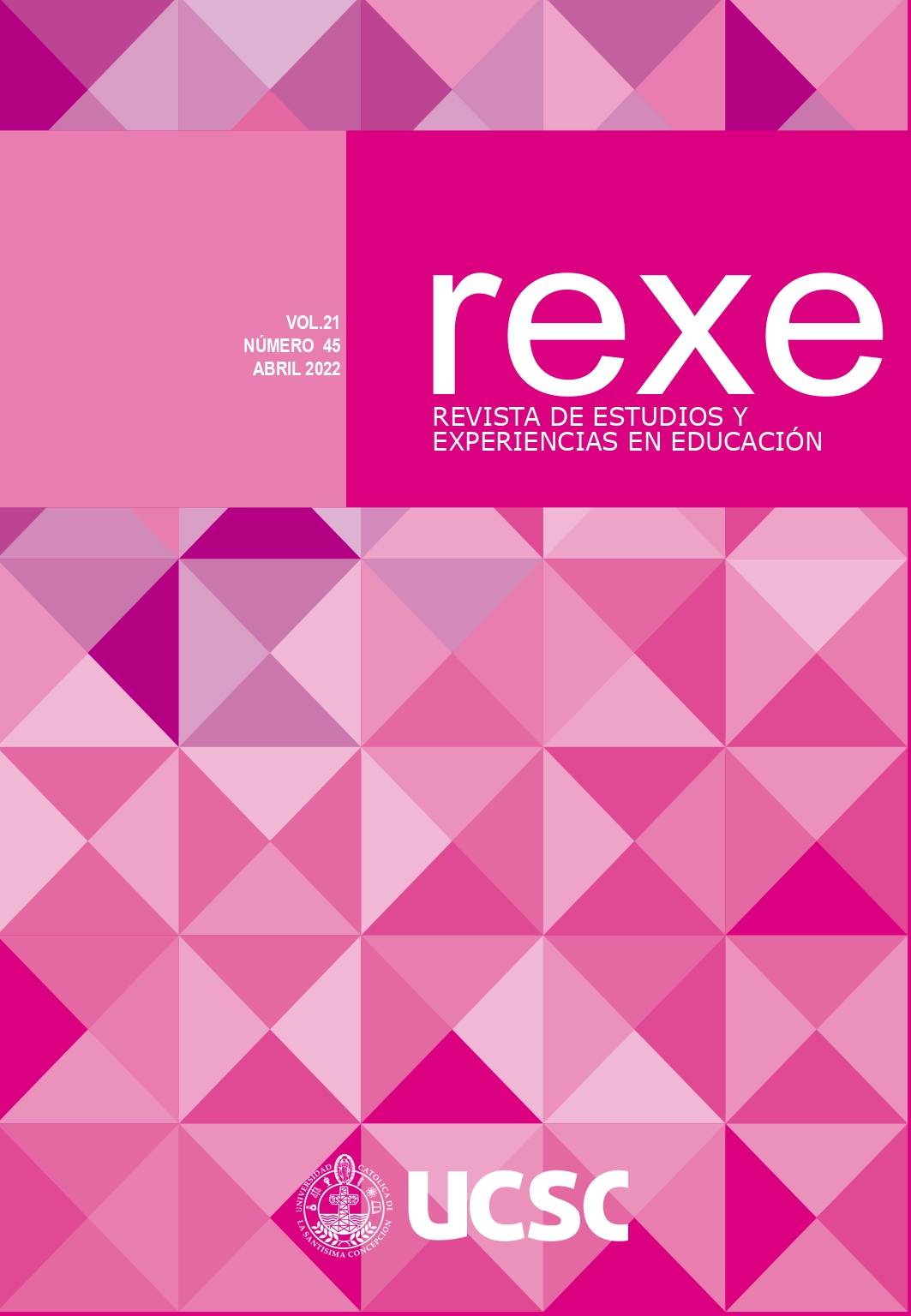Neurociencia y orientaciones ministeriales chilenas de aprendizaje socioemocional en primer ciclo
DOI:
https://doi.org/10.21703/0718-5162.v21.n45.2022.005Resumen
Ante un escenario crítico de salud mental y factores que alteran el neurodesarrollo afectivo típico en la población, durante el 2020 el Ministerio de Educación ha dispuesto de orientaciones curriculares para afrontar el aprendizaje socioemocional. Por tal motivo, se realizó una revisión sistemática de las investigaciones de neurodesarrollo del sistema límbico y de las referencias bibliográficas de las orientaciones ministeriales de aprendizaje socioemocional. Se obtuvieron 140 estudios publicados entre el 2015 y el 2020 de neurodesarrollo del sistema límbico y 167 artículos referenciados por las orientaciones ministeriales, que fueron analizadas siguiendo una adaptación del modelo PRISMA. Del análisis realizado, se concluye que las orientaciones curriculares poseen un sustento teórico-empírico apoyado principalmente por la psicología y con escaso aporte de las neurociencias. Se sugiere que el MINEDUC tome en consideración aportes del neurodesarrollo del sistema límbico para una mejor contextualización del aprendizaje socioemocional.
Descargas
Referencias
Abend, R., Swetlitz, C., White, L. Shechner, T., Bar-Haim, Y., Filippi, C., Kircanski, K., Haller, S., Benson, B., Chen, G., Leibenluft, E., Fox, N., y Pine, D. (2020). Levels of early-childhood behavioral inhibition predict distinct neurodevelopmental pathways to pediatric anxiety. Psychological Medicine, 50(1), 96-106.
Achterberg, M., Bakermans-Kranenburg, M., van Ijzendoorn, M., van der Meulen, M., Tottenham, N., y Crone, E. (2018). Distinctive heritability patterns of subcortical-prefrontal cortex resting state connectivity in childhood: A twin study. NeuroImage, 175, 138–149.
Acosta, H., Tuulari, J., Scheinin, N., Hashempour, N., Rajasilta, O., Lavonius, T., Pelto, J., Saunavaara, V., Parkkola, R., Lähdesmäki, T., Karlsson1, L., y Karlsson, H. (2019). Maternal pregnancy-related anxiety is associated with sexually dimorphic alterations in amígdala volume in four-year-old children. Frontiers in behavioral neuroscience, 13, 175.
Banihashemi, L., Wallace, M., Sheu, L., Lee, M., Gianaros, P., Mackenzie, R., Insana, S. Germain, A., y Herringa, R. (2017). Childhood maltreatment moderates the effect of combat exposure on cingulum structural integrity. Development and psychopathology, 29(5), 1735–1747.
Bisquerra, R. (2009). Psicopedagogía de las emociones. Síntesis.
Bisquerra, R., y Pérez, N. (2012). Educación emocional: estrategias para su puesta en práctica. Revista de la Asociación de Inspectores de Educación de España, 16(16), 1-11.
Bollinger, J., Scott-Smith, S., y Mendes, P. (2017). How complex developmental trauma, residential out-of-home care and contact with the justice system intersect. Children Australia, 42(2), 108.
CADEM. (2019). El Chile que viene salud 2019. Recueprado de cadem.cl/encuestas/chileque-viene-salud-mental/.
Callaghan, B., Gee, D., Gabard-Durnam, L., Telzer, E., Humphreys, K., Goff, B., Shapiro, M., Flannery, J., Lumian, D., Fareri, D., Caldera, C., y Tottenham, N. (2019). Decreased amígdala reactivity to parent cues protects against anxiety following early adversity: an examination across 3 years. Biological Psychiatry: Cognitive Neuroscience and Neuroimaging, 4(7), 664-671.
CASEL. (2019). What is Sel: CASEL. Recuperado de https://casel.org/what-is-sel/.
Chernyshenko, O., Kankaraš, M., y Drasgow. M. (2018). Social and emotional skills for student success and well-being. OECD Education Working Papers No. 173. Recuperado de https://www.oecd-ilibrary.org/docserver/db1d8e59-.
Choi, E., Taylor, M., Hong, S., Kim, C., y Yi, S. (2018). The neural correlates of attachment security in typically developing children. Brain and cognition, 124, 47–56.
Durlak, J., Weissberg, R., Dymnicki, A., Taylor, R., y Schellinger, K. (2011). The impact of enhancing students’ social and emotional learning: A meta-analysis of school-based universal interventions. Child development, 82(1), 405-432.
Educación 2020. (2020). 2° Encuesta Online: #EstamosConectados.Recuperado de https://educacion2020.cl/encuestas/estamosconectados/resultados_encuesta2.
Enatsu, R., Gonzalez-Martinez, J., Bulacio, J., Kubota, Y., Mosher, J., Burgess, R., Najm, I., y Nair, D. (2015). Connections of the limbic network: a corticocortical evoked potentials study. Cortex, 62, 20-33.
Fondo de las Naciones Unidas para la Infancia. (25 de abril de 2019). UNICEF alerta sobre altos índices de violencia intrafamiliar hacia los niños en Chile. [Comunicado de prensa]. Recuperado de https://www.unicef.org/chile/comunicados-prensa/unicef-alerta-sobre-altos-%C3%ADndices-de-violencia-intrafamiliar-hacia-los-ni%C3%B1os-en.
Gabard-Durnam, L., O’Muircheartaigh, J., Dirks, H., Dean III, D., Tottenham, N., y Deoni, S. (2018). Human amygdala functional network development: A cross-sectional study from 3 months to 5 years of age. Developmental cognitive neuroscience, 34, 63-74.
Gaffrey, M., Barch, D., Bogdan, R., Farris, K., Petersen, S., y Luby, J. L. (2018). Amygdala Reward Reactivity Mediates the Association Between Preschool Stress Response and Depression Severity. Biological psychiatry, 83(2), 128–136.
Gamarra, Á., y Velarde, K. (2017). Sistema límbico y educación emocional. Alétheia, 5(1), 43-53.
Garaigordobil, M. (2018). La educación emocional en la infancia y la adolescencia. Participación educativa, 5(8), 105-128.
Gao, A., Xia, F., Guskjolen, A., Ramsaran, A., Santoro, A., Josselyn, S., y Frankland, P. (2018). Elevation of Hippocampal Neurogenesis Induces a Temporally Graded Pattern of Forgetting of Contextual Fear Memories. The Journal of neuroscience: the official journal of the Society for Neuroscience, 38(13), 3190–3198.
Gee, D. (2016). Sensitive Periods of Emotion Regulation: Influences of Parental Care on Frontoamygdala Circuitry and Plasticity. New directions for child and adolescent development, 2016(153), 87–110.
Glejzer, C., Ciccarelli, A., Chomnalez, M., y Ricci, A. (2019). La incidencia de las emociones sobre los procesos de aprendizaje en niños, niñas y jóvenes en contextos de vulnerabilidad social. Voces de la Educación, (2), 113-128.
Graham, A. Pfeifer, J., Fisher, P., Carpenter, S., y Fair, D. (2015). Early life stress is associated with default system integrity and emotionality during infancy. Journal of child psychology and psychiatry, and allied disciplines, 56(11), 1212–1222.
Hernández, R., Fernández, C., y Baptista, P. (2014). Metodología de la investigación. (6° ed). McGraw-Hill. Instituto Nacional de la Juventud. (2018). Informe general de resultados. Recuperado de http://www.injuv.gob.cl/storage/docs/IX_ENCUESTA_NACIONAL_DE_LA_JUVENTUD_2018.pdf.
Jedd, K., Hunt, R., Cicchetti, D., Hunt, E., Cowell, R., Rogosch, F., Toth, S., y Thomas, K. (2015). Long-term consequences of childhood maltreatment: Altered amygdala functional connectivity. Development and psychopathology, 27(4 Pt 2), 1577–1589.
Kerr, K., Ratliff, E., Cosgrove, K., Bodurka, J., Morris, A., y Simmons, W. (2019). Parental influences on neural mechanisms underlying emotion regulation. Trends in neuroscience and education, 16, 100118.
Kuhlman, K., Geiss, E., Vargas, I., y Lopez-Duran, N. (2018). HPA-Axis Activation as a Key Moderator of Childhood Trauma Exposure and Adolescent Mental Health. Journal of abnormal child psychology, 46(1), 149–157.
LeGates, T., Kvarta, M., Tooley, J., Francis, T., Lobo, M., Creed, M., y Thompson, S. (2018). El comportamiento de recompensa está regulado por la fuerza de las sinapsis hipocamponúcleo accumbens. Nature, 564 (7735), 258-262.
Ley 20.370 de 2009. Diario Oficial de la República de Chile, Santiago, Chile, 12 de septiembre de 2009.
Liberati, A., Altman, D., Tetzlaff, J., Mulrow, C., Gøtzsche, P., Ioannidis, J., Clarke, M., Devereaux, PJ., Kleijnen, J., y Moher, D. (2009). The PRISMA statement for reporting systematic reviews and meta-analyses of studies that evaluate health care interventions: explanation and elaboration. Journal of clinical epidemiology, 62(10), e1-e34.
Liberzon, I., Ma, S., Okada, G., Shaun Ho, S., Swain, J., y Evans. (2015). Childhood poverty and recruitment of adult emotion regulatory neurocircuitry. Social Cognitive and Affective Neuroscience, 10, 1596-1606.
McLaughlin, K., Weissman, D., y Bitrán, D. (2019). Childhood adversity and neural development: a systematic review. Annual review of developmental psychology, 1, 277-312.
Ministerio de Desarrollo Social y Familia. (2020). Informe de Desarrollo Social 2020. Recuperado de http://www.desarrollosocialyfamilia.gob.cl/storage/docs/Informe_de_Desarrollo_Social_2020.pdf.
Morawetz, C., Bode, S., Derntl, B., y Heekeren, H. R. (2017). The effect of strategies, goals and stimulus material on the neural mechanisms of emotion regulation: A meta-analysis of fMRI studies. Neuroscience & Biobehavioral Reviews, 72, 111-128.
Neuenschwander, R., Hookenson, K., Brain, U., Grunau, R., Devlin, A., Weinberg, J., Diamond, A., y Oberlander, T. F. (2018). Children's stress regulation mediates the association between prenatal maternal mood and child executive functions for boys, but not girls. Development and psychopathology, 30(3), 953–969.
Oberle, E., McLachlan, K., Catherine, N., Brain, U., Schonert-Reichl, K., Weinberg, J., y Oberlander, T. (2017). Afternoon cortisol provides a link between self-regulated anger and peer-reported aggression in typically developing children in the school context. Developmental psychobiology, 59(6), 688–695.
Organización de las Naciones Unidas para la Educación, la Ciencia y la Cultura. (2009). SERCE: Segundo Estudio Regional Comparativo y Explicativo: los aprendizajes de los estudiantes de América Latina y el Caribe; reporte técnico. Recuperado de https://unesdoc.unesco.org/ark:/48223/pf0000190297.
Organización de las Naciones Unidas para la Educación, la Ciencia y la Cultura. (2015). Replantear la educación ¿hacia un bien común mundial?. Ediciones UNESCO. Recuperado de https://unesdoc.unesco.org/ark:/48223/pf0000232697.
Organización para la Cooperación y Desarrollo Económicos (2016). Habilidades para el progreso social: El poder de las habilidades sociales y emocionales. UNESCO Institute for Statistics, Paris.
Opendak, M., Gould, E., y Sullivan, R. (2017). Early life adversity during the infant sensitive period for attachment: Programming of behavioral neurobiology of threat processing and social behavior. Developmental cognitive neuroscience, 25, 145-159.
Perry, N., Donzella, B., Parenteau, A., Desjardins, C., y Gunnar, M. (2019). Emotion regulation and cortisol reactivity during a social evaluative stressor: A study of post-institutionalized youth. Developmental psychobiology, 61(4), 557–572.
Perry, R., Rincón-Cortés, M., Braren, S., Brandes-Aitken, A., Opendak, M., Pollonini, G., Chopra, D., Cybele, C., Alberini, C., Blair, C., y Sullivan, R. (2019). Corticosterone administration targeting a hypo-reactive HPA axis rescues a socially-avoidant phenotype in scarcity-adversity reared rats. Developmental cognitive neuroscience, 40, 100716.
Pessoa, L., y Hof, P. R. (2015). From Paul Broca's great limbic lobe to the limbic system. Journal of Comparative Neurology, 523(17), 2495-2500.
Romund, L., Raufelder, D., Flemming, E., Lorenz, R., Pelz, P., Gleich, T., Heinz, A., y Beck, A. (2016). Maternal parenting behavior and emotion processing in adolescents-An fMRIstudy. Biological psychology, 120, 120–125.
Roos, L., Giuliano, R., Beauchamp, K., Gunnar, M., Amidon, B., y Fisher, P. (2017). Validation of autonomic and endocrine reactivity to a laboratory stressor in young children. Psychoneuroendocrinology, 77, 51–55.
Salzwedel, A., Stephens, R., Goldman, B., Lin, W., Gilmore, J., y Gao, W. (2019). Development of amygdala functional connectivity during infancy and its relationship with 4-year behavioral outcomes. Biological Psychiatry: Cognitive Neuroscience and Neuroimaging, 4(1), 62-71.
Silvers, J., Insel, C., Powers, A., Franz, P., Helion, C., Martin, R., Weber, J., Mischel, W., Casey, B., y Ochsner, K. (2017). vlPFC-vmPFC-Amygdala Interactions Underlie Age-Related Differences in Cognitive Regulation of Emotion. Cerebral cortex, 27(7), 3502–3514.
Tallot, L., Doyère, V., y Sullivan, R. M. (2016). Developmental emergence of fear/threat learning: neurobiology, associations and timing. Genes, brain, and behavior, 15(1), 144–154.
Taylor, R., Oberle, E., Durlak, J., y Weissberg, R. (2017). Promoting positive youth development through school-based social and emotional learning interventions: A meta-analysis of follow-up effects. Child development, 88(4), 1156-1171.
Thijssen, S., Collins, P., y Luciana, M. (2020). Pubertal development mediates the association between family environment and brain structure and function in childhood. Development and psychopathology, 32(2), 687–702.
Thomason, M., y Marusak, H. (2017). Within-subject neural reactivity to reward and threat is inverted in young adolescents. Psychological medicine, 47(9), 1549–1560.
Torres, J., Córdoba, W., Cerón, L., Amézquita, C., y Bastidas, T. (2015). Correlación funcional del sistema límbico con la emoción, el aprendizaje y la memoria. Morfolia, 7(2), 29-44.
Tottenham, N. (2015). Social scaffolding of human amygdala-mPFCcircuit development. Social neuroscience, 10(5), 489-499.
Tottenham, N., y Gabard-Durnam, L. (2017). The developing amygdala: a student of the world and a teacher of the cortex. Current opinion in psychology, 17, 55–60.
Vidal-Ribas, P., Benson, B., Vitale, A., Keren, H., Harrewijn, A., Fox, N., Pine, D., y Stringaris, A. (2019). Bidirectional Associations Between Stress and Reward Processing in Children and Adolescents: A Longitudinal Neuroimaging Study. Biological psychiatry. Cognitive neuroscience and neuroimaging, 4(10), 893–901.
Weissman, D., Bitran, D., Miller, A., Schaefer, J., Sheridan, M., y McLaughlin, K. (2019). Difficulties with emotion regulation as a transdiagnostic mechanism linking child maltreatment with the emergence of psychopathology. Development and psychopathology, 31(3), 899–915.
Yoshihara, K., Tanabe, H., Kawamichi, H., Koike, T., Yamazaki, M., Sudo, N., y Sadato, N. (2016). Neural correlates of fear-induced sympathetic response associated with the peripheral temperature change rate. NeuroImage. 134, 522–531.
Descargas
Publicado
Número
Sección
Licencia
Política de acceso abierto
Esta revista proporciona un acceso abierto inmediato a su contenido, basado en el principio de que ofrecer al público un acceso libre a las investigaciones ayuda a un mayor intercambio global de conocimiento.
Licencia
Revista REXE "Revista de Estudios y Experiencias en Educación" de la Facultad de Educación, Universidad Católica de la Santísima Concepción, está distribuido bajo una Licencia Creative Commons Atribución 4.0 Internacional.






